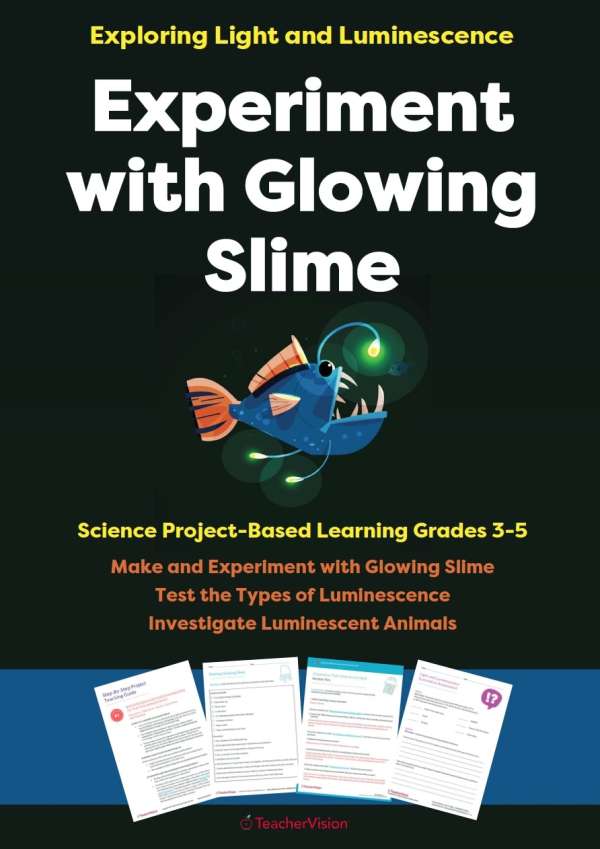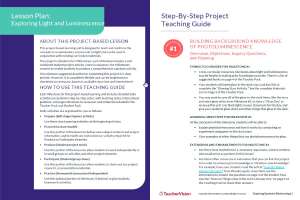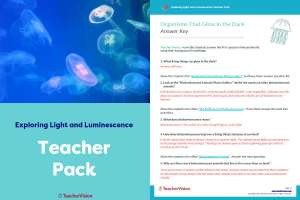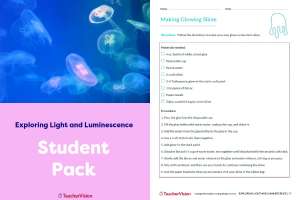
Included with a Premium Membership
Subscribe for instant access to this and every resource on TeacherVision.
A Comprehensive NGSS-Aligned Lesson on Luminescence
Research and explore the 3 types of luminescence, perform hands-on experiments with glow sticks and stars to understand the differences, discover and report on different kinds of luminescent animals, and make glow-in-the-dark slime to experiment with in this life science PBL unit.
Your students will learn all about light in the animal world in this complete project-based learning unit on luminescence for grades 3-5 life science. They'll research and experiment with photoluminescence, chemiluminescence, and bioluminescence, learn hands-on how to compare and contrast different types with hands-on activities, go on a bioluminescent animals scavenger hunt and present their findings, and make glow-in-the-dark slime to experiment with as they demonstrates their understanding of luminescence.
What's Inside
Packed with hands-on inquiry-based activities, extensions and enhancements, cross-curricular independent and group work, and engaging and interactive challenges, this 59-page project-based unit comes complete with:
- For the Teacher: A complete luminescence Lesson Plan with step-by-step instructions for all activities, teaching tips, assessment guidance, and inquiry questions.
- For Students: A full-color Student Pack complete with all of the printables and instructions students need for the research, experiments and activities - just print (or share) and teach!
A complete, ready-to-teach Teacher Pack that includes:
- Teacher versions of all the student printables with step-by-step annotations and notes for teaching luminescence;
- Formative and summative assessments, answer keys, and a full project rubric;
- Instructions and guidance for the extension activities and project enhancements;
- Materials and resources lists, links to articles and videos, plus additional resources for lecture and presentation.
What's Included
Lesson Plan - Step-by-Step Project Guide
- Milestone 1: Building Background Knowledge of Photoluminescence
- Milestone 2: Building Background Knowledge of Chemiluminescence
- Milestone 3: Building Background Knowledge of Bioluminescence
- Milestone 4: Making Slime Demonstrate Luminescence
- Milestone 5: Experimenting with Luminescence
Teacher and Student Resources
- Materials Needed for the Projects in this Unit
- Books About Light and Luminescence
- How Do Things Glow in the Dark? Answer Key
- Things That Glow in the Dark Answer Key
- Glowing Stars Activity Answer Key
- Glow Sticks Answer Key
- Glow Sticks Activity Answer Key
- Organisms That Glow in the Dark Answer Key
- Slideshow Mini-Lesson
- Sample Bioluminescent Animal Slide
- Light and Luminescence Quick Quiz
- Light and Luminescence Quick Quiz Answer Key
- Making Glowing Slime Teacher Notes
- Light and Luminescence Summative Assessment
- Light and Luminescence Summative Assessment Answer Key
- Light and Luminescence Rubric
- How Do Things Glow in the Dark?
- Things That Glow in the Dark
- Glowing Stars Activity
- Milestone #1 Inquiry Question
- Glow Sticks
- Glow Sticks Activity
- Milestone #2 Inquiry Question
- How to Do Good Research
- Bioluminescent Animals
- Organisms That Glow in the Dark
- Glowing Sea Creatures Scavenger Hunt
- Milestone #3 Inquiry Question
- Making Glowing Slime
- Milestone #4 Inquiry Question
- Testing Slime for Luminescence
- Milestone #5 Inquiry Question



OVERVIEW:
This project-based learning lesson is designed to support and reinforce the concepts taught as part of a lesson on Light and Luminescence. It is built around 5 inquiry-based milestones that incorporate cross-curricular hands-on projects, formative and summative assessments, independent and group activities, and extensions.
STUDENT/GROUP OUTPUT:
In the course of this project-based learning unit, students will:
- Research and document the unique characteristics of photoluminescence, chemiluminescence, and bioluminescence as background knowledge for the rest of the project;
- Perform hands-on experiments and activities with glow sticks and glow-in-the-dark stars to further their understanding of the luminescent properties of living and non-living things;
- Explore bioluminescence in nature by going on a "scavenger hunt" of information about types of bioluminescent animals and reporting their findings to the class;
- "Show what they know" by making and experimenting with glow-in-the-dark slime to demonstrates synthesized knowledge of the three types of luminescence and make connections to the function of bioluminescence in nature.
SUGGESTED SUBJECT PREREQUISITES:
Students will acquire necessary background knowledge of luminescence as part of this project, and instructional materials for providing that background are included in the Teacher Pack.
SEQUENCE AND PACING
This project-based unit is divided into 5 milestones. The minimum suggested duration for completing this project-based unit is 5 class periods. However, the unit is completely flexible can be lengthened or shortened as necessary or desired, based on available class time and interest level.
TECHNOLOGY RESOURCES (suggested):
- Internet access
- Slide presentation software (PowerPoint, Google Slides)
STANDARDS ALIGNMENT
These activities support the following NGSS curriculum standards:
- LS1.A: Structure and Function
- 4-LS1-1 Construct an argument that plants and animals have internal and external structures that function to support survival growth, behavior, and reproduction
- LS3.b Variation of Traits
- 3-LS3-2 Use evidence to support the explanation that traits can be influenced by the environment.
- PS1.A Structure and Properties of Matter
- 5-PS1-3 Make observations and measurements to identify materials based on their properties
- PS1.B Chemical Reactions
- 5-PS1-4 Conduct an investigation to determine whether the mixing of two or more substances results in new substances
- PS3.A Definitions of Energy
- 4-PS3-2 Make observations to provide evidence that energy can be transferred from place to place by sound, light, heat, and electric currents.



